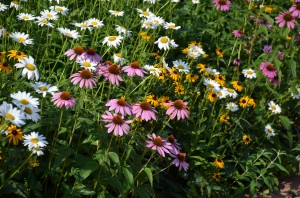Gardeners are looking for simple plant combinations and this photo, shot at Kingwood Center in Mansfield, Ohio, shows three easy to grow perennials, “no-brainers” as some might call them. Originally, all three plants emigrated from the prairie where each coped with hot summers without much rainfall.
In the hands of modern plant breeders, each perennial has been greatly improved. All are disease and pest resistant. Some cultivars are fairly new, others are old-timers, and all are reliable:
‘Goldsturm’ or ”Little Goldstar’ black eyed Susan (Rudbeckia fulgida)
‘Becky’ or ‘Amelia’ Shasta daisy (Leucanthemum superbum)
‘Kim’s Knee High’, ‘Magnus’ or ‘Pow Wow Wild Berry’ coneflower (Echinacea purpurea)
Buy from local greenhouse growers or garden centers where you live. You may also order from reliable plant dealers on-line. All perennials should be purchased as vegetative cuttings and from “true to type” seed sources.
Prepare the planting bed in late winter. All perennials listed above grow in average garden soil, although they do benefit from generous additions of compost. Fertilize (10-10-10 or equivalent @2 lbs. per 100 square feet of garden bed) after planting the perennials. In addition, spread Preen® weed preventer over the bed after planting and irrigate after all chores are finished. Water your new perennial bed as needed through long dry spells during the first 6 weeks. Usually these tough prairie plants should handle the summer weather conditions ahead.
By mid-autumn after frost, cut (mow) the bed to prevent the distribution of perennial seeds. Rake up the plant debris and apply a fall application of Preen® to prevent germination of winter annual weeds.
Over the next 3-4 summers your new perennial bed should look glorious.


 Posted in
Posted in 
